|
|
|
| My Favourite Planet > English > People > Exekias |
|
| |
Exekias
Ancient Greek mythology, religion and art
Exekias (Ἐξηκίας; signature ΕΧΣΕΚΙΑΣ, Exsekias, or even ΕΑΧΣΕΚΙΑΣ, Eaxsekias, see below) was a potter and vase painter in Athens, active around 550-525 BC. He is considered to be the best black-figure painter. His signature as painter and potter has been found on two vases, and another ten as potter only. Around 32 vases (some now only fragments) are attributed to him. He is also credited with inventing new pottery shapes: the calyx-krater and the standard "type A" cup.
He taught the Andokides Painter, who with Psiax, is among those credited with the invention of red-figure painting around 530 BC.
His most famous work is an inscribed black-figure belly amphora (Type A), found in Vulci, Erturia (Lazio, Italy), and dated circa 540-530 BC. It is signed by Exekias twice: on Side A as potter, and on the mouth as painter and potter. Side A has a depiction of Achilles and Ajax (names inscribed) playing a board game. See depictions of this scene by other vase painters in Homer part 2. This image is still mass-reproduced on ceramics today and sold in tourist shops across Italy and Greece (see Now wait for last month at The Cheshire Cat Blog). Side B shows the homecoming of the Dioskouroi: Kastor and Polydeukes return to their immortal mother Leda and mortal father Tyndareos (all four names inscribed). Height 61 cm. The Gregorian Museum of Etruscan Art, Vatican Museums, Rome. Inv. No. 16757 (344).
Other works attributed to Exekias include:
The "Dionysus Cup", 540-530 BC, a black-figure Type A kylix (an eye-cup) decorated on the inside with a painting of Dionysus in a ship surrounded by dolphins. Signed on the foot Έχσηκίας έποίησε (Exsekias epoise, Exekias made it). From Vulci, Etruria (Lazio, Italy). Diameter 30 cm. Staatliche Antikensammlungen, Munich. Inv. No. 2044.
A black-figure calyx-krater painted by Exekias, depicting the apotheosis of Herakles (see photo below). From the Agora, Athens. Agora Museum. Inv. No. AP 1044.
An inscribed black-figure belly amphora, circa 540 BC, signed on Side A by Exekias as potter, Έχσηκίας έποίεσε (Exsekias epoiese, Exekias made it). Painted by a member of Group E. On side A a depiction of Herakles fighting Geryon (see image below). On Side B a warrior leaving home in a chariot. On the lid Sirens and stags. From Vulci. Louvre Museum, Paris. Inv. No. F 53.
A black-figure neck amphora, painted by Exekias, circa 540-535 BC. On Side A Achilles killing the Amazon queen Penthesileia. On Side B, Memnon, bearded and fully armed, facing right, flanked by two black African attendants. Inscribed above one, behind (left of) Memnon's head, έπ]οίησ(ε)ν (?); above the other, in front of Memnon's head, AMAΣIΣ (Αμασις). Scholars remain uncertain whether the inscription is the signature of Amasis as potter, or Exekias making a humorous comment on the potter's name or nickname, possible "dusky" appearance or foreign origin. Height 41.5 cm, width 30 cm, weight 3.6 kg. British Museum. Inv. No. GR 1849.5-18.10 (Vase B209).
The name AMAΣΟΣ (Amasos) also appears above a similar black African warrior being attacked by Menelaos on a fragmentary panel amphora painted by Exekias, circa 530 BC. University Museum, Philadelphia. Inv. No. MS 3442.
A black-figure amphora signed on both sides by Exekias as potter, Έχσηκίας έποίησε (Exsekias epoise, Exekias made it), inscribed retrograde (backwards). Circa 530-525BC. Side A depicts Achilles killing the Amazon queen Penthesileia. ΑΧΙΛΕΥΣ inscribed in front of Achilles; ΠΕΝΘΕΣΙΛΥΑ inscribed in front of Penthesilea; on the right Όνητορίδης καλός (Onetorides kalos, Onetorides is beautiful). On Side B Dionysus holding out a kantharos (wine cup) to his son Oinopion, who holds an oinochoe (wine jug). Inscribed retrograde ΣΟΣΝΟΙΔ (SOSNOID = Διόνυσος, Dionysos) in front of Dionysus. Inscribed OINOΠION above Oinopion, and behind him Όνητορίδης καλός, as on Side A. Height 41 cm, width 29 cm, diameter of mouth 18 cm. British Museum. Inv. No. 1836,0224.127 (Vase B210).
A black-figure neck amphora, from Vulci, signed on the mouth by Exekias as painter. On Side A Herakles (name inscribed) fighting the Nemean Lion. On Side B Demophon and Akamas leading their horses (names of the men and horses inscribed) as they leave for Troy. The horse on the left is named Φαλιος (Falios, dazzling white, or having a white forehead). The name also appears to the right of the mule's head on the funerary pinax in Berlin (see photo, above right), and on an unattributed black-figure hydria in the Louvre (Inv. No. F 40). The horse on the right is named Καλλιφορα<ς> (Kallifora<s>, a horse with beautiful mane and tail). A horse on Side B of amphora F 53 in the Louvre (see above) is named Kalliforas. Height 40.5 cm. Berlin State Museums (SMB). Inv. No. F 1720.
An inscribed black-figure Panathenaic prize amphora, perhaps from Vulci. On Side A Athena. On Side B wrestlers. Badisches Landesmuseum, Karlsruhe. Inv. No. 65.45.
The Suicide of Ajax Vase, a black-figure neck amphora, around 530-525 BC, with a depiction of Ajax preparing for his suicide ( see image below). Musée des Beaux-Arts et d'Archéologie, Boulogne, France. Inv. No. 558. |
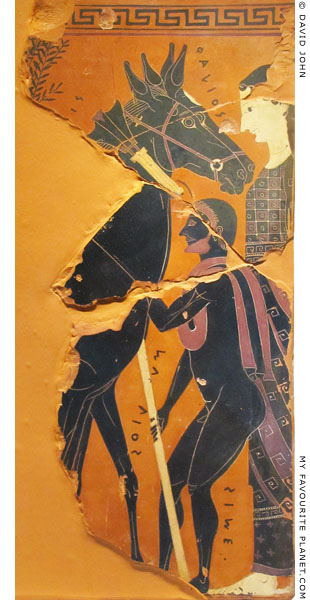
Fragments of an inscribed Attic
black-figure ceramic funerary pinax
(plaque), painted by Exekias.
On the left the fronts of two mules, facing
right, probably harnessed to a cart. Left of
their heads are branches of an olive tree.
A bearded slave, naked apart from a cloak,
faces the mules and holds a pole. Behind
him stands a large female, facing left.
Around 540 BC. Height 37 cm.
Altes Museum, Berlin.
Inv. No. F 1814. Acquired in 1875.
One of 15 fragmentary funerary plaques
by Exekias (Inv. Nos. F 1811-1826) found
in 1872 in Outer Kerameikos, Athens.
Probably broken deliberately in antiquity. |
| |
| |
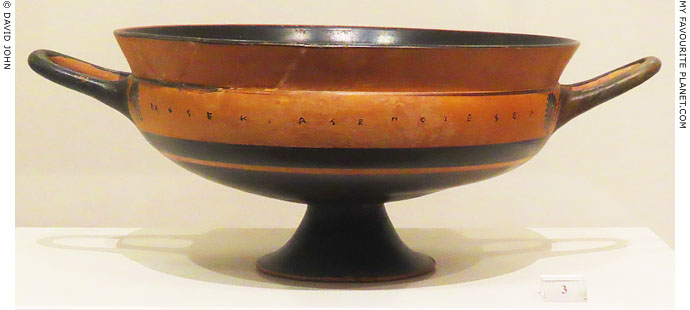
The signature of Exekias as potter on the outside of an Attic
black-figure lip cup (a deep kylix or drinking cup).
ΕΑ+ΣΕΚΙΑΣ ΕΠΟΙΕΣΕΝ
Έαξσηκίας έποίησεν
Eaxsekias made (me)
On the other side (B) is what is thought to be nonsense inscription:
ΕΝΕΟΙΝΟΙΟΙΕΝ
Perhaps: εν η οινο(ν) ιοιεν
Made in Athens about 550-540 BC, Ripe Archaic period (570-530 BC).
The cup has no figurative or abstract decoration, and has a plain,
glossy black interior. From Corinth. Height 14.5 cm, diameter 21 cm.
National Archaeological Museum, Athens. Inv. No. 1104. |
| |
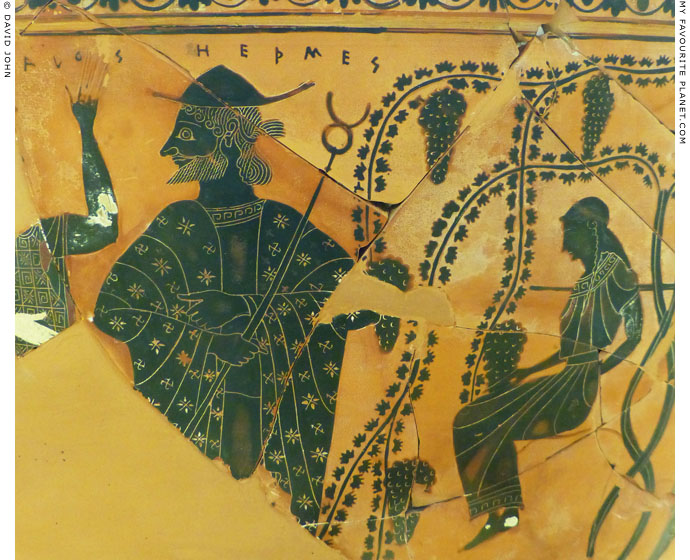
Detail of a fragmentary inscribed Attic black-figure calyx-krater
painted by Exekias, depicting Hermes and other deities taking
part in the deification of Herakles and his introduction to Olympus.
Around 530 BC. Found in 1937 in a well on the
North Slope of the Athens Acropolis. Height 44.5 cm.
Museum of the Ancient Agora, Athens. Inv. No. AP 1044.
|
The name ΗΕΡΜΕΣ (Hermes) is painted clearly above the god's head. Typical of Exekias' style are the bold composition and the finely incised drawing of contours and details, such as Hermes' hair and beard, and the patterns of his garments: the meander on the collar of his tunic, and flowers/stars and swastikas on his cloak.
Hermes is finely dressed for the special occasion. He carries a long kerykeion (caduceus), and wears a petasos over his elaborately styled hair, which is tied up in a krobylos at the back. To the right, tendril-like vines, loaded with bunches of grapes, fill the space and seem to dance in the breeze. The grapes are made plastic by the simple trick of indicating the highlights of individual fruits with C-shaped incisions. Among the vines sits a small female figure in profile, her head now just a silhoutte.
To the left of Hermes (not shown in photo) Athena drives the chariot carrying Herakles to Mount Olympus.
Side B of the krater shows the fight between Greek and Trojan warriors over the body of the fallen Patrokles (see Homer part 2); in the lower zone lions attacking a bull. |
|
|
| |
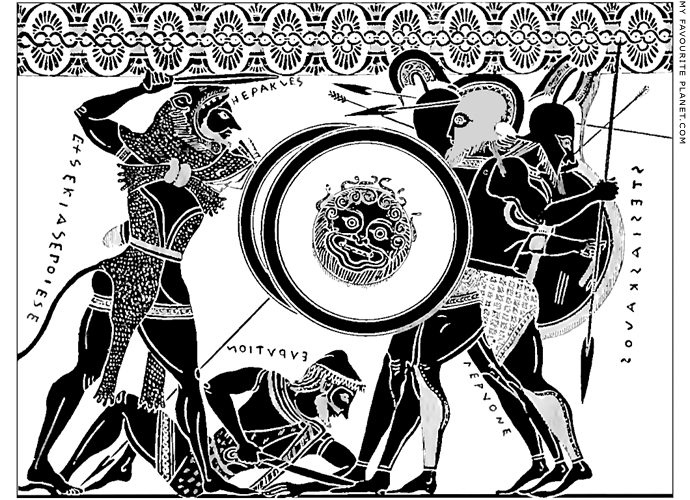
Herakles fighting the triple-bodied monster Geryon.
One of the Twelve Labours of Herakles.
The panel of a black-figure belly amphora, signed by Exekias as potter,
Έχσηκίας έποίεσε (Exsekias epoiese, Exekias made it), behind Herakles.
Painted by a member of Group E. From Vulci, Etruria (Lazio, Italy).
On each of his three heads Geryon wears a Corinthian helmet with a crest, two of which
are set high. He has greaves on his six legs, carries three spears and a corselet appears
to cover his united torso. A hypnotic Gorgoneion device can be seen on one of his three
round shields, but it will not save him from Herakles determined attack - the hero will
always find victory - and two arrows from his bow have already found their target.
Louvre Museum, Paris. Inv. No. F 53.
Image source: Olivier Rayet and Maxime Collignon, Histoire de la
céramique grecque, fig. 55, page 117. Georges Decaux, Paris, 1888. |
| |
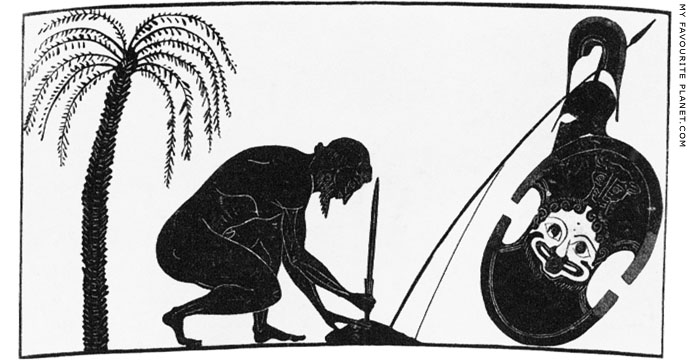
Ajax preparing for his suicide on the panel on side A of a black-figure
neck amphora by Exekias, around 530-525 BC.
The naked Greek hero plants the hilt of his sword in a mound of earth. On the left stands
a palm tree and to the right his armour, a spear, a Corinthian helmet and a shield decorated
with the head of a lioness (or panther) over a Gorgoneion. The scene is unique in ancient
Greek art, since other depictions of this incident show Ajax falling on his sword or stabbing
himself rather than preparing for his death (see Homer part 2).
On Side B: youths, some draped, with a chariot.
Musée des Beaux-Arts et d'Archéologie, Boulogne, France. Inv. No. 558.
Image source: Ernst Pfuhl, Malerei und Zeichnung der Griechen. Munich, 1923. |
| |
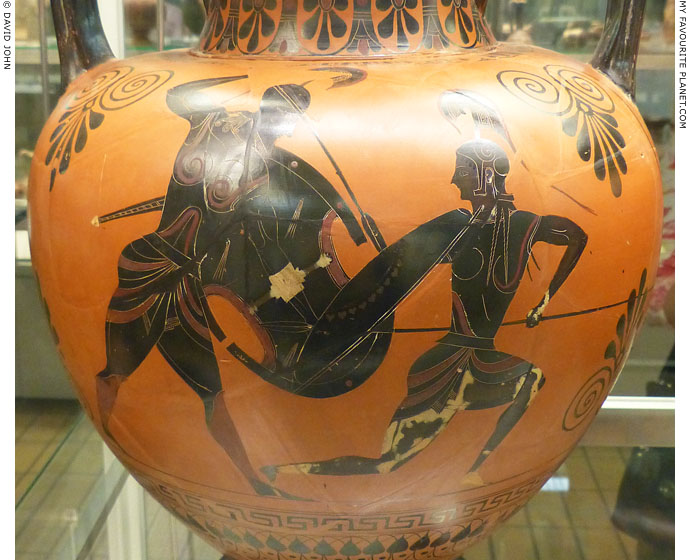
Detail of a black-figure amphora attributed to the painter Exekias with a depiction of
the Greek hero Achilles fighting the Amazon queen Penthesileia (see Homer part 2).
Made in Athens about 540-530 BC.
British Museum, London. Inv. No. GR 1849.5-18.10 (Vase B 209). |
| Photos and articles © David John, except where otherwise specified. |
 |
Visit the My Favourite Planet Group on Facebook.
Join the group, write a message or comment,
post photos and videos, start a discussion... |
|
|
| |
|
|
| |
| |
 |
| |
 |
| |
 |
| |
 |
| |
 |
| |
 |
| |
George Alvanos
rooms in
Kavala's historic Panagia District
Anthemiou 35,
Kavala, Greece
kavalarooms.gr
|
| |
Olive Garden Restaurant
Kastellorizo,
Greece
+30 22460 49 109
kastellorizo.de
|
| |
Papoutsis
Travel Agency
Kastellorizo,
Greece
+30 22460 49 286
greeklodgings.gr
|
| |
|